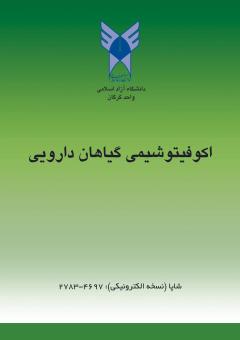تحلیل فعالیتهای آنزیمی، پتانسیل آنتیاکسیدانی و محتوای اسانس گونه¬های مختلف درمنه در طی مراحل مختلف رشدی
محورهای موضوعی : اکولوژی محیطیزینب زینلی 1 , Alireza Ladan Moghadam 2 * , معصومه مازندرانی 3 , خدایار همتی 4
1 - گروه علوم باغبانی، دانشگاه آزاد اسلامی واحد علیآباد کتول، گلستان، ایران
2 - گروه علوم باغبانی، دانشگاه آزاد اسلامی واحد گرمسار، سمنان، ایران
3 - عضو هیات علمی دانشگاه آزاد اسلامی واحد گرگان
4 - گروه علوم باغبانی، دانشگاه علوم کشاورزی و منابع طبیعی گرگان، گلستان، ایران
کلید واژه:
چکیده مقاله :
این پژوهش بهمنظور ارزیابی پتانسیل آنتیاکسیدانی و میزان اسانس دو گونه درمنه (A. sieberi و A. annua) در دو زیستگاه طبیعی استان گلستان (توسکستان و کلاله) در طول دو سال (1401-1403) و در سه مرحله رشدی (رویشی، گلدهی و تشکیل بذر) انجام شد. نمونهبرداری بهصورت تصادفی از هر زیستگاه و گونه در هر مرحله رشدی صورت گرفت صفات مورد بررسی شامل: روشهای اندازه گیری ظرفیت آنتیاکسیدانی (DPPH، FRAP و ABTS) و فعالیت آنزیمهای آنتیاکسیدانی (CAT، POD و SOD) و میزان اسانس بوده است. نتایج تجزیه واریانس نشان داد که نوع گونه، مرحله نمو و زیستگاه و اثرات متقابل آنها تأثیر معنیداری بر بیشتر صفات داشته است. بیشترین فعالیت مهار رادیکال DPPH در سال اول درA. annua (38/73%) و در سال دوم در A. sieberi (06/68%) در مرحله رویشی و گلدهی در زیستگاه کلاله مشاهده شد. بیشترین قدرت احیاکنندگی آهن (FRAP) در سال اول درA. sieberi و در سال دوم نیز در همین گونه در مراحل رویشی و گلدهی در زیستگاه کلاله بهدست آمد. بیشترین فعالیت آنزیم CAT در سال اول در A. annua و A. sieberi و در سال دوم درA. sieberi در مراحل رویشی و گلدهی در زیستگاه کلاله مشاهده شد. بیشترین میزان اسانس در هر دو سال در A. sieberi در مرحله گلدهی زیستگاه کلاله بهترتیب 96/1% و 12/2% بود. تحلیل رگرسیون گام به گام نشان داد که فعالیت DPPH،CAT و FRAP بهطور معنیداری بر میزان اسانس تأثیرگذار بودند. این پژوهش نشان میدهد که پتانسیل آنتیاکسیدانی و میزان اسانس گونههای درمنه تحت تأثیر عوامل ژنتیکی و محیطی قرار دارد و گونه A. sieberi در زیستگاه کلاله در مرحله گلدهی، بیشترین میزان اسانس را تولید کرده بود.
This research was conducted to evaluate the antioxidant potential and essential oil content of two Artemisia species (A. sieberi and A. annua) in two natural habitats of Golestan Province (Tuskestan and Kalaleh) over two years (2022-2024) and at three growth stages (vegetative, flowering, and seed setting). Sampling was performed randomly from each habitat and species at each growth stage, and antioxidant potential (DPPH, FRAP, and ABTS), antioxidant enzyme activities (CAT, POD, and SOD), and essential oil content were measured. The results of the analysis of variance indicated that species, growth stage, habitat, and their interactions had a significant effect on most traits. The highest DPPH radical scavenging activity in the first year was observed in A. annua (73.38%) and in the second year in A. sieberi (68.06%) at the vegetative and flowering stages in the Kalaleh habitat. The highest ferric reducing antioxidant power (FRAP) in the first year was obtained in A. sieberi, and in the second year also in the same species, at the vegetative and flowering stages in the Kalaleh habitat. The highest catalase (CAT) enzyme activity in the first year was observed in A. annua and A. sieberi, and in the second year in A. sieberi, at the vegetative and flowering stages in the Kalaleh habitat. The highest essential oil content in both years was found in A. sieberi at the flowering stage in the Kalaleh habitat, with 1.96% and 2.12%, respectively. Stepwise regression analysis revealed that DPPH, CAT activity, and FRAP significantly influenced the essential oil content. This study demonstrates that the antioxidant potential and essential oil content of Artemisia species are influenced by genetic and environmental factors, with A. sieberi in the Kalaleh habitat at the flowering stage exhibiting the highest essential oil content.

